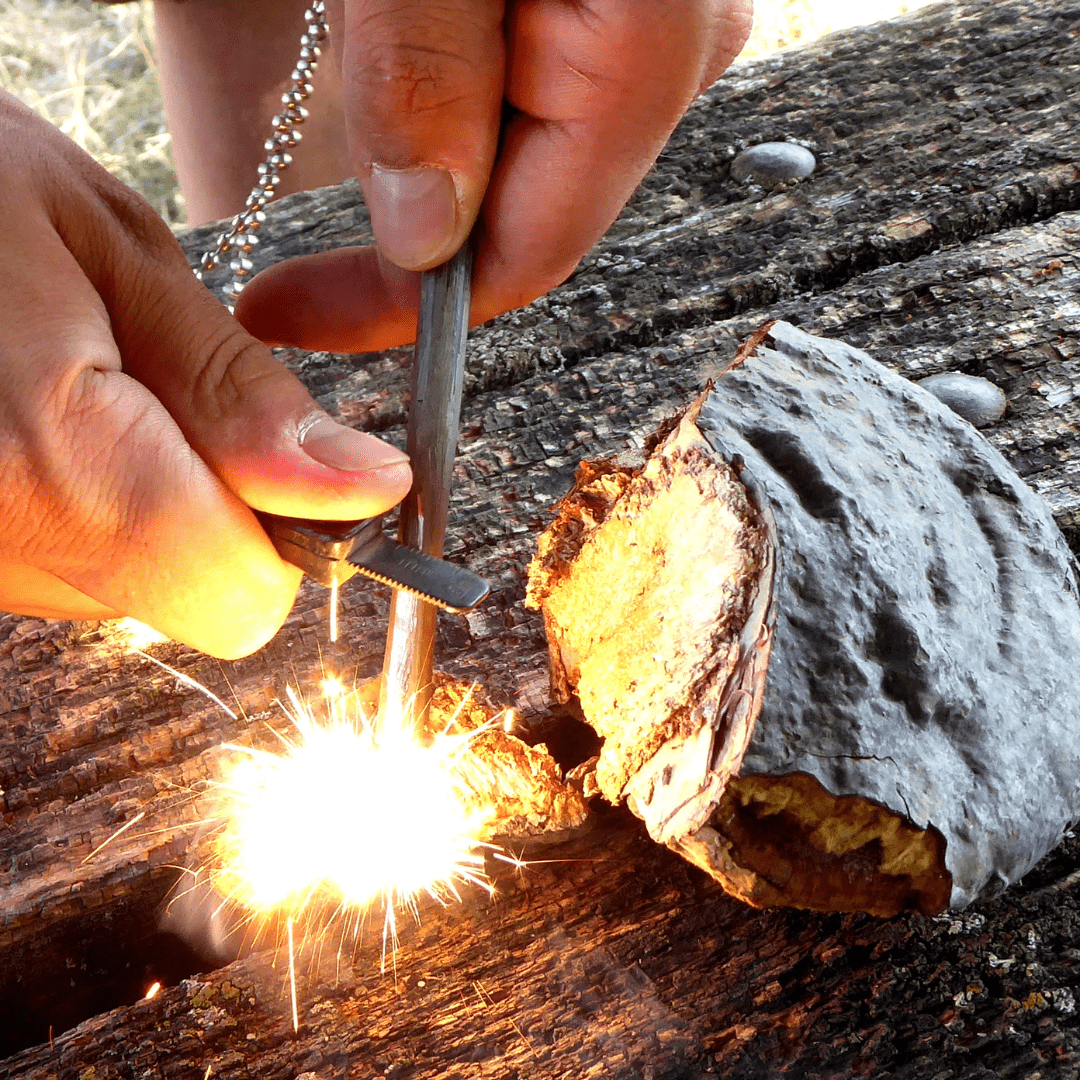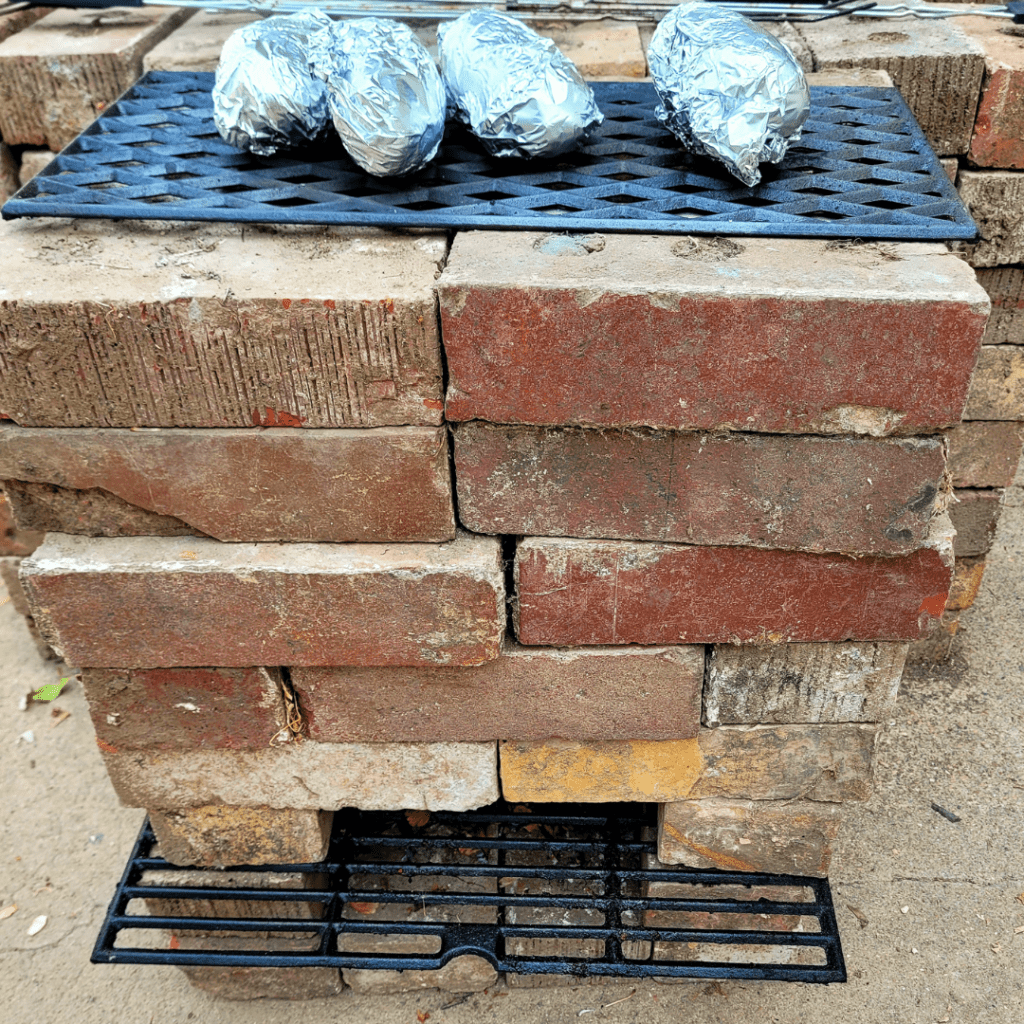Learn how to build a no-fail fire starter survival kit that works every time. Perfect for prepping, camping, and emergency situations.
Being able to start a fire in any situation is a survival skill you can’t afford to skip. I’ve tested countless methods, and over time, I’ve built a no-fail fire starter kit that works whether I’m camping, off-grid, or facing an emergency. In this post, I’ll show you exactly what I include in my kit and how to make sure it works when you need it most.
This is a pinnable post. Tap or hover over any image in this post to pin to your Pinterest Boards.
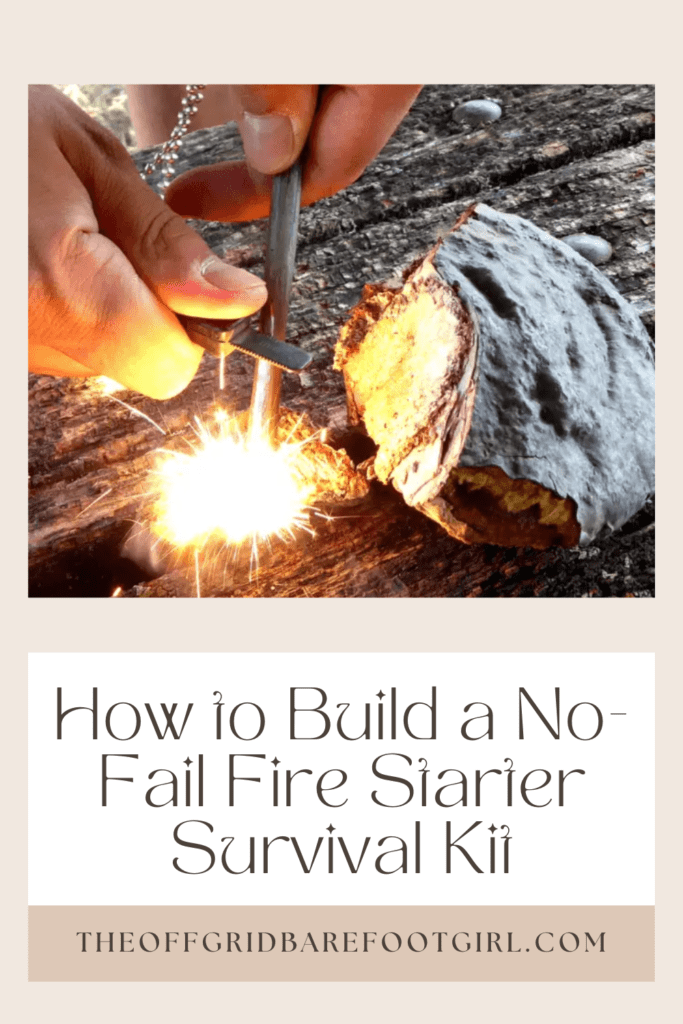
The Importance of a No-Fail Fire Starter Survival Kit
Having a solid fire starter survival kit is something I never leave home without—even if I’m not heading deep into the wilderness. It’s essential not just for camping or outdoor adventures, but also during a power outage at home. Fire is one of those survival basics you can’t skimp on, especially in cold weather. You need it for warmth, cooking, and peace of mind when the lights go out or you’re spending the night outdoors. With a reliable, no-fail fire starter kit, I can start a fire in rain, wind, snow—even using the sun’s rays.
Being able to start a fire isn’t just about comfort. It can signal for help, purify water, and cook a hot meal when you need it most. But starting a fire isn’t always easy if you’re unprepared. That’s why I make sure my fire starter survival kit is ready to go, so I can count on it no matter the conditions.
Essential Fire Starting Tools: What You Need in Your Kit
When it comes to fire starting tools, there are a few key items to include in your survival kit. Let’s break it down:
Fire Starters
Fire starters are the superheroes of the fire making world. They ignite quickly and burn long enough to catch your tinder and kindling on fire. Look for compact and waterproof options such as fire starter sticks, waterproof matches, or homemade fire starters like cotton balls soaked in petroleum jelly.
Ignition Sources
You can’t start a fire without a way to light it up. Include reliable ignition sources like waterproof matches, lighters, and ferrocerium rods (also known as fire steel). Having multiple options ensures you won’t be left in the dark when one fails you.
Tinder and Kindling
Tinder is the spark-catching fuel that gets your fire started, while kindling keeps it burning. Include a variety of tinder options such as dryer lint, cotton balls, or commercially available tinder tabs. For kindling, gather small twigs and branches from the environment or pack some in your kit beforehand.
Choosing the Right Fire Starters: Options and Considerations
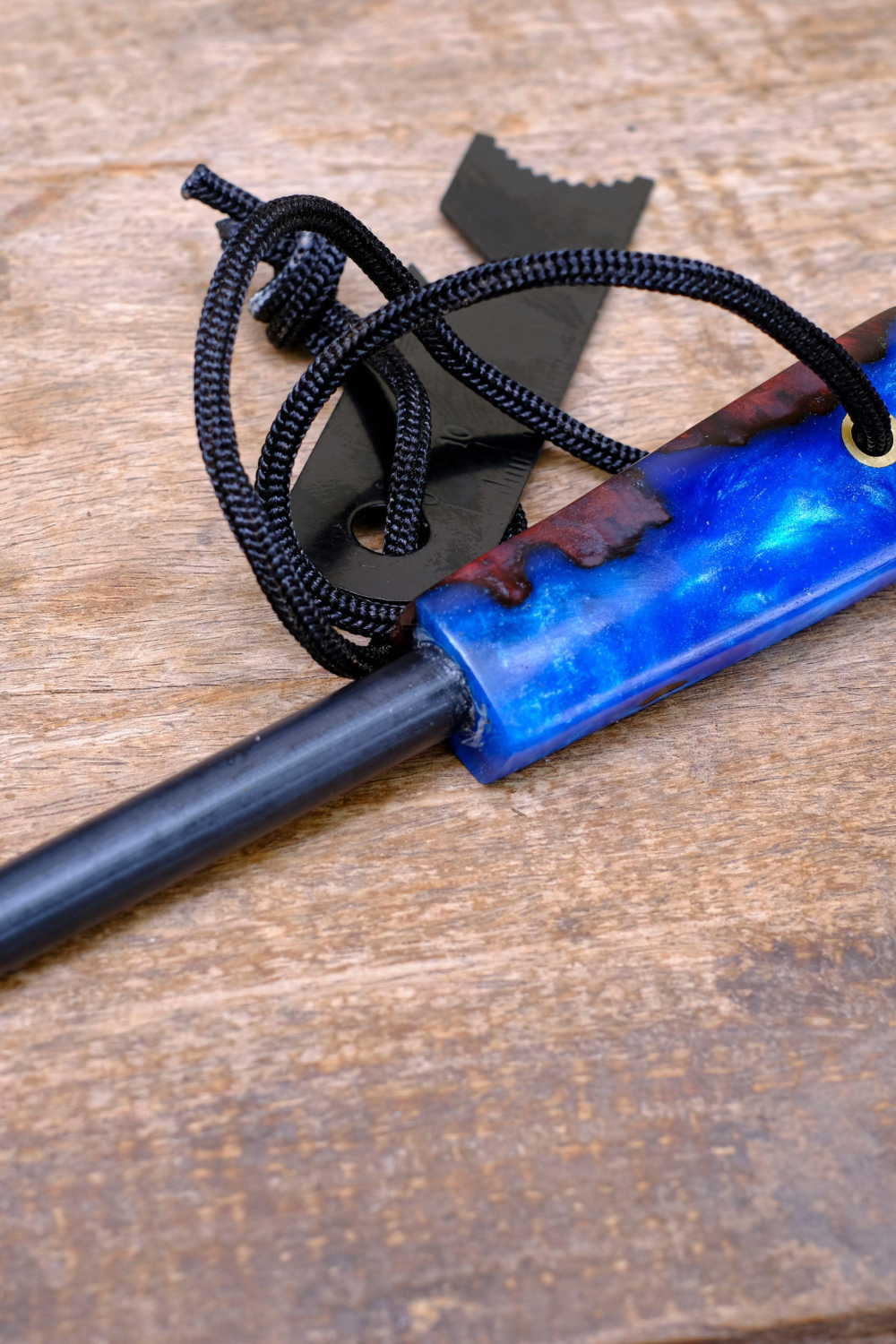
Now that you know what you need, it’s time to choose the right fire starters for your survival kit. Let’s explore some options and considerations to keep in mind:
Matches
Ah, the classic match. It’s reliable, it’s simple, but make sure you opt for waterproof matches to ensure they’ll work even in damp conditions. Also, pack them in a waterproof container for extra protection. Pro tip: bring extra matches, because you never know when you might need a backup.
Lighters
Lighters are a popular choice for their convenience and ease of use. However, they can be affected by altitude, extreme temperatures, or running out of fuel. Consider a windproof lighter that operates in various weather conditions, and always make sure you have a spare or two.
Ferrocerium Rods
For those who want a more rugged and long-lasting option, ferrocerium rods are the way to go. They produce sparks when struck with a metal object, like a knife or a dedicated striker. While they take a bit of practice to master, they are reliable and can endure harsh conditions.
Building a Waterproof Container: Keeping Your Fire Starters Dry
Water and fire aren’t the best of friends, so it’s crucial to keep your fire starters dry. Here’s how:
Selecting a Waterproof Container
Invest in a durable and waterproof container to protect your fire starters from moisture. Options like a small dry bag, a plastic container, or even a metal tin can do the trick. Just make sure it seals tightly to keep the elements at bay.
Organizing and Securing Fire Starters
Now, you don’t want to be rummaging through your entire survival kit just to find a match. Keep your fire starters organized and easily accessible by using ziplock bags or small pouches. Additionally, consider attaching a lanyard or cord to your container to prevent it from getting lost or misplaced during your adventures.
Fire Starting Techniques: Mastering the Art of Ignition
Starting a fire is a skill that has been passed down through generations, and it’s a skill that every survivalist should have in their arsenal. In this section, we’ll explore three tried and true fire starting techniques that will have you igniting flames like a pro.
The Teepee Fire Lay
Imagine building a cozy little teepee in the wilderness, but instead of crawling inside, you’re going to set it on fire (don’t worry, it won’t be your home). The teepee fire lay is a classic technique that involves arranging your kindling and fuel in a cone shape, creating enough airflow to get that fire roaring. It’s a great technique for quickly generating heat and flames, perfect for cooking or providing warmth during chilly nights in the great outdoors.
The Log Cabin Fire Lay
If you’ve ever played with Lincoln Logs as a kid, you’ll have no problem mastering the log cabin fire lay. This technique involves stacking larger pieces of firewood in a criss-cross pattern, creating a sturdy foundation for your fire. Once the base is set, you can add smaller kindling in the gaps between the logs, creating a structure that allows for a sustained burn. The log cabin fire lay is great for longer-lasting fires, making it ideal for situations where you need warmth and a light source throughout the night.
The Dakota Fire Hole Technique
If you’re looking for a more discreet fire option, the Dakota Fire Hole technique might be just what you need. This technique involves digging a hole in the ground and creating a chimney by tunneling another hole at an angle, connecting it to the main hole. By lighting your fire inside the main hole, the chimney effect draws in oxygen, allowing the fire to burn efficiently while reducing smoke. The Dakota Fire Hole is perfect for situations where you need to keep a low profile, like when you’re trying to avoid attracting unwanted attention or when you’re camping in an area with fire restrictions.
Tips for Building a Successful Fire: Fuel Sources and Fire Safety
Building a fire isn’t just about knowing the right techniques; it’s also about having the right fuel sources and prioritizing fire safety. In this section, I’ll explore some tips to help you build a successful fire and avoid turning your survival situation into a “Survivor” audition tape.
Identifying Suitable Fuel Sources
When it comes to fuel sources, not all wood is created equal. You’ll want to look for dry, seasoned wood that snaps easily when broken. Dead branches, fallen logs, and even pine cones can make excellent kindling. Avoid using green or wet wood, as it will be harder to ignite and produce a lot of smoke. Remember, a successful fire is all about having the right fuel, so keep your eyes peeled for potential firewood as you explore your surroundings.
Fire Safety Precautions
While fire can be a useful tool, it can also be a dangerous one, especially in the wild. Always prioritize fire safety to prevent accidents and unwanted forest fires. Clear the area around your fire pit, removing any flammable materials like dry grass or leaves. Keep a water source nearby in case things get out of hand, and never leave your fire unattended. Remember, fires can spread quickly, so it’s better to play it safe and always err on the side of caution.
Maintaining and Updating Your Fire Starter Survival Kit
Just like a well-stocked pantry, your fire starter survival kit needs regular attention and maintenance. In this section, I’ll cover some essential steps to ensure your kit is always ready to ignite.
Regular Inspection and Maintenance
Take some time to inspect your fire starter kit on a regular basis. Make sure all your tools, like matches and lighters, are in good working condition. Replace any worn-out or expired items, and double-check that your tinder and kindling materials are still dry and effective. It’s better to discover any issues with your kit in the comfort of your home than when you’re out in the wilderness, counting on it for survival.
Replenishing Supplies
As you use your fire starter kit, remember to replenish your supplies. Keep an eye on the levels of your lighter fluid, matches, and other consumables, and restock as needed. It’s always a good idea to have some backup supplies in case of emergencies, so don’t hesitate to grab an extra pack of waterproof matches or another fire starter tool when you have the chance.
Discover how to build the best fire starter survival kit with the finest tools on the market.
Emergency Fire Kit: Fire Starter Survival Kit
Having an all-in-one emergency fire kit is the perfect way to keep all your fire starter survival kit items together. This emergency fire kit is a great starter kit. It supplies you with everything you need to build a successful fire. This fire starter survival kit supplies you with waterproof fire tools, carbon-steel strikers, char cloths, magnifying lenses, and a fire tender.
Having this useful carry bag to keep all of your fire starter survival kit items together makes for nice convenience for a grab-and-go before heading out the door on an adventure. It is also useful to keep in your survival pantry for unexpected power outages when you need to build a fire in your backyard or wood-burning stove.
The best thing about starting with this emergency fire kit is that you can add to it with other fire-starting items and make it your own. You can use fire-starting items that work the best for you and your experience level, and what you are most comfortable using.
Have a look at some useful fire starting tool options.
Flint and Steel Starter Kit
I have a Ferro strike rod; however, this one comes with tinder wick rope to easily start a fire and control the size of the flame! The sparks that you strike go directly to the wick rope, and it ignites quickly, even in wind and rain!
The first Ferro rod that I have ever owned and used is just a plain Ferro rod. While it works wonders, it is difficult to hold the tender as close as possible to the rod and strike sparks at the same time. This flint and steel starter kit offers a quick and easy solution that sends every spark struck right to the tender wick rope!
You can adjust the size of the rope allotted to control the size of the flame you need. You want to use as less of rope as possible to carry the flame to the fire tender you intend to build your fire. This will help you use less of the tender wick rope, so you can have it for future fires.
This flint and steel fire starter kit will not fail you! The tender wick rope even works when it has been drenched in the pouring rain, snow, or a body of water!
Stormproof Matches
You need to have good-quality stormproof matches so that the flame can stand against the wind. These stormproof matches come in a handy waterproof case, which can be tucked away in any emergency bag or stored in your survival pantry. My goal is to have several of these cases in a basket in my own survival pantry to grab as needed.
It is always a good idea to travel with stormproof matches in case of a quick emergency, especially on a small hike. These cases are small enough to fit snuggly in your pocket or backpack. You never know, a small hike can turn into an emergency situation quickly, and it would be nice to have stormproof matches should you become injured and need to build a survival fire until rescue.
These stormproof matches are even great just to quickly start a fire in your woodburning stove or outdoor firepit. Do not be caught without stormproof matches should the power go out!
Fire Starter Squares
These fire starter squares are perfect and convenient to keep in your fire starter kit. With these fire starter squares, you can light any fire instantly, even if they have gotten wet!
They are small and will fit in your backpack and not take up much room, and are very essential to survival. These fire starter squares are made up of recycled wood chips and wax and are perfect to start fires for grills, campfires, fire pits, woodburning stoves, smokers, and survival fires.
Keep in mind, these fire starter squares are extremely flammable and keep lit long enough to get your fire going.
Windproof Butane Torch Lighter
Having a good quality windproof butane torch lighter in your fire starter kit is essential. This is a rechargeable and refillable butane torch lighter that offers a single one-inch jet flame that can burn thicker branches or wood for starting a fire.
This butane torch lighter is a must-have in your no-fail fire starter kit as it packs a powerful flame! Forget the need to keep tiny tinder on hand when you have a strong flame that can start a fire with branches! (Keep that handy tinder, though, still important too!)
Be sure to keep them well charged and have extra butane fuel stored to keep using these powerful butane torch lighters for your handy fires!
Conclusion
Building a no-fail fire starter survival kit is about more than just having the right tools and techniques. It’s about being prepared for any situation that comes your way. Whether you’re an avid camper, a seasoned survivalist, or simply someone who wants to be ready for unexpected events, knowing how to start a fire and maintain a well-equipped kit will give you the confidence and peace of mind to tackle whatever challenges Mother Nature throws your way.
Building a no-fail fire starter survival kit is an essential step for anyone who enjoys outdoor activities or wants to be prepared for emergencies. By selecting the right tools, understanding different fire starting techniques, and maintaining your kit, you can ensure that you are equipped to start a fire in any situation. Remember, fire is not only a source of warmth and comfort, but also a vital tool for survival. So, take the time to build your kit, practice your skills, and be confident in your ability to ignite a fire when you need it most. With a well-prepared fire starter survival kit, you’ll be ready to face the challenges of the wilderness and stay safe in any outdoor adventure. So go forth, friends, and may your fires always be lit and your s’mores always be golden.
Ensure you’re ready for any emergency by learning more in The Complete Guide to Emergency Preparedness: Everything You Need to Thrive in Any Situation.
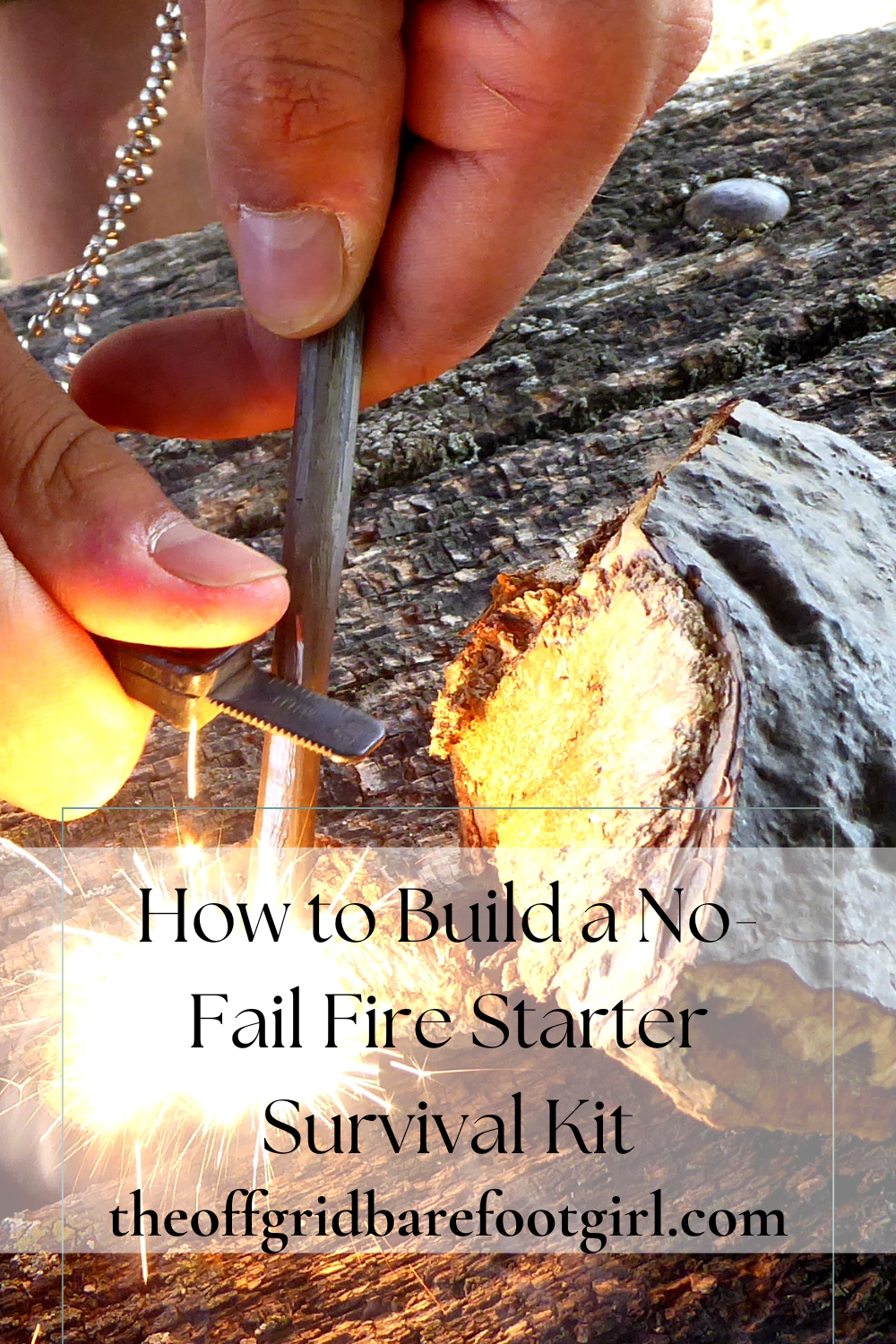
Frequently Asked Questions
1. What should be included in a basic fire starter survival kit?
A basic fire starter survival kit should include essential tools such as fire starters (matches, lighters, or ferrocerium rods), ignition sources, and tinder or kindling. It is also recommended to have a waterproof container to keep the fire starters dry and organized.
2. How do I choose the right fire starter for my kit?
Choosing the right fire starter depends on your personal preference and the specific conditions you anticipate encountering. Matches are convenient and easy to use, but may be affected by moisture. Lighters are reliable, but can run out of fuel. Ferrocerium rods are durable and work well in different weather conditions. Consider the pros and cons of each option and select the one that best suits your needs.
3. What are some important fire safety precautions to keep in mind?
Fire safety should always be a top priority when starting a fire outdoors. Some essential precautions to keep in mind include clearing the surrounding area of flammable materials, ensuring the fire is contained within a fire ring or designated area, and never leaving the fire unattended. It is also crucial to fully extinguish the fire before leaving the site or going to sleep.
4. How often should I inspect and update my fire starter survival kit?
Regular inspection of your fire starter survival kit is important to ensure that all tools and supplies are in good condition and ready for use. It is recommended to inspect and update your kit at least once a year, replacing any expired or damaged items. Additionally, it is a good idea to periodically practice using your fire starters and replenish your supplies as needed.
Firestarter Supplies Printable List
Summary
I hope I have inspired you to live sustainably with these tips and products.
If you were encouraged by this post, I invite you to check out my FREE Printables Page for fun free printables, planners, and charts.
ENTER MY FREE Printables Page HERE
Here are some more of my gardening inspiration posts to check out!
How to Feed Your Family During the Government Shutdown
12 Best Tips for Creating an Eco-Friendly Household
Survival Lessons from the Great Depression
The Best 15 Homesteading Blogs to Follow for Inspiration
How to Criminal-Proof Your Home with These 5 Steps
How to Create Your Cottagecore Aesthetic Dream Home
Ideas for Rustic Living Room Vibes You’ll Love All Year Round!
How to Prep Your Home for Chilly Fall Nights
Bring Back the Magic of Fireflies and Lightning Bugs with Solar Power!
The Ultimate Portable Power Bank for Homesteaders and Preppers!
A Bug Out Bag That’s Actually Ready — When You Need It Most!
Magical Ways to Use Fairy Lights in Your Off-Grid Home
How to Live a Cozy Off-Grid Life
The Best Off-Grid Kitchen Tools for Indoors (No Power Needed!)
DIY Solar Made Simple: How I Powered My Off-Grid Life with Practical Preppers!
Sleeper Cells in America: What You Need to Know Now!
How People Are Surviving in Broken Cities with Broken Systems
When the World Hurts, We Prepare with Purpose
How to Live On Raw Land: Everything You Need to Know!
How to Do Off-Grid Laundry with Eco-Friendly Laundry Detergent!
Hollywood on Fire! What Secrets Are In the Ashes?
FEMA Concentration Camps? Are Echos of the Past Returning?
How Likely Is a Russian EMP? One Pulse Could Black Us Out!
What Dark Secrets Lie in The Bird Flu Symptoms?
The Blackout Sun: Who Is Blacking Out Our Sunlight?
More Posts!
How to Bug-In During a Deep Freeze!
‘FOGVID-24?’ What’s in the Mysterious Fog That’s Making Everyone Sick?
From Snow to Sow: Plan Your Spring Garden Now!
11 Fun Ways to Brighten Your Spring Garden with Personality
Top 10 Spring Garden Crops to Harvest in 30 Days and Eat Now!
The Best Survival Crops for Caloric Survival
More Posts!
My Victory Garden: What I Learned from 5+ Years
Why Every Family Should Have a Victory Garden in Their Backyard Now!
The Best Perennials for a Long-Term Survival Garden
The Best Essential Oils for Plants That Repel Garden Bugs
How to Grow Green Garden Peas: Perfect Plump Peas!
Hugelkultur: Does This Epic Pioneering Method Actually Work?
9 Ways to Celebrate Earthing Day in Your Garden!
Gardening Indoors: Secrets of Growing Your Food Inside!
How to DIY a Milk Jug Drip Irrigation System!
Why Cedar Mulch Is The Perfect Natural Weed Barrier
Gardening Projects
Onions: How to Grow Onions for Storage
Peas: How to Grow Garden Peas for a Bumper Crop
Carrots: How to Grow Carrots for a Bountiful Harvest
Prep Your Garden for Spring Planting with These Expert Tips!
How to Grow a Prepper Garden to Survive and Thrive
The Best Garden Tools You Need for a Productive Season
Fastest Growing Vegetables for Your Survival Garden
How to Grow Marigolds As Pest Control In Your Vegetable Garden
Must-Have Tools for a Successful Balcony Vegetable Garden
How to Effectively Combat Powdery Mildew in Your Garden
The Best Tips for Organic Gardening
How to Release Ladybugs In Your Garden for Organic Pest Control
More Posts!!
The Best Garden Snail Control Strategies
The Best Spring Vegetables to Grow in Your Garden
Seed Starter Mix: How To Make Your Organic Seed Starter Mix At Home
How to Grow a Productive Canning Garden
How to Plant and Grow a Salsa Garden
Easiest Heirloom Vegetable Seeds to Grow Now
How to Use the Hand Twist Claw Tiller: Tackling Tough Soil
More Fun Gardening Posts to Check Out!
Planning Your Garden: How to Plan a Vegetable Garden: Expert Green Thumb Tips!
Winterizing the Garden: How to Winterize Your Vegetable Garden: Step-by-Step Checklist
Mulching the Garden: How to Make Leaf Litter Mulch
Grow a Pumpkin Patch: How to Grow a Pumpkin Patch in Your Backyard
How to Grow a Fall Garden: 9 Best Fall Crops
Clever Ways to Incorporate Indoor Composting into Your Home
How to Start Composting for the Garden: A Step-by-Step Guide
The Ultimate Guide to Composting in Your Suburban Backyard
Why I Built A Survival Garden in My Backyard
16 Best Medicinal Herbs to Grow in Your Garden Now
Blessings,
The Off Grid Barefoot Girl

